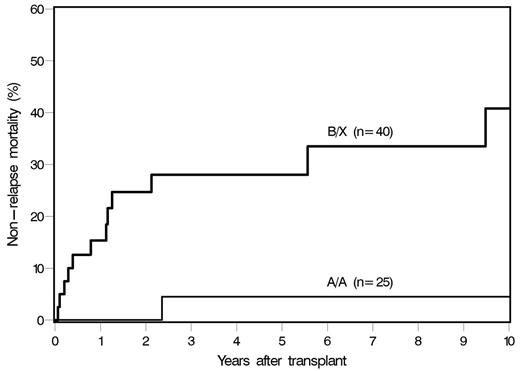Abstract
Although outcomes after allogeneic hematopoietic cell transplantation (alloHCT) for AML have improved, this has mainly been attributed to a reduction in transplant-related mortality rather than reduced leukemia relapse. NK cell alloreactivity is regulated by inhibitory and activating signals mediated through cell-surface receptors including the killer immunoglobulin-like receptors (KIRs). Group A and B KIR haplotypes have distinct centromeric (Cen) and telomeric (Tel) gene-content motifs and donor Cen group B KIR haplotypes have been reported to be associated with decreased relapse and improved survival in AML patients undergoing unrelated donor alloHCT. We hypothesized that donor KIR genotype may also be predictive of outcomes after matched related donor (MRD) alloHCT. We evaluated 93 AML patients in CR1/CR2 who underwent T-cell replete alloHCT using HLA- matched related donors at our institution from 1/2000-3/2013. Sixty-six had myeloablative conditioning (MAC) that that was busulfan/cyclophosphamide-based and 27 had reduced-intensity conditioning (RIC) with fludarabine/total body irradiation or busulfan/fludarabine. Donors were KIR genotyped to assign haplotypes A/A vs. B/X and the distinctive Cen and Tel gene-content motifs of group A and B KIR haplotypes according to the presence or absence of one or more B haplotype-defining KIR genes. KIR B–content score for each KIR genotype was defined as the number of Cen and Tel gene-content motifs containing B haplotype–defining genes (range, 0-4). As compared to those with haplotypes B/X (n=40; B content scores of 1-4) those with haplotype A/A (n=25; B content score of 0) undergoing MAC had significantly lower 100-day, 6-, 12- and 24-month non-relapse mortality (NRM) (8% vs. 0%, 13% vs. 0%, 15% vs. 0%, 25% vs. 0%, respectively, Figure 1) which was confirmed on multivariable analysis (HR 9.19, p=0.03). There were no differences between these groups regarding patient and transplant-related characteristics, or for acute or chronic GVHD, relapse, or survival. The causes of death in the group with haplotypes B/X were most commonly attributed to infection and then GVHD. However, within the group with B/X haplotypes, the B motif content score (1-4) was not associated with significant differences in NRM (HR 0.79, p=0.56). No difference in outcomes was observed for those undergoing RIC. The number of donor activating KIR genes (2SD1, 2DS2, 2DS3, 2DS4, 2DS5, and 3DS1) was then assessed. As compared to those with 3-6 activating KIR genes (n=20) those with 0-2 (n=41) undergoing MAC had significantly lower 100-day, 6-, 12- and 24-month non-relapse mortality (NRM) (15% vs. 0%, 15% vs. 5%, 15% vs. 5%, 29% vs. 8%, respectively, Figure 2) which was confirmed on multivariable analysis (HR 4.07, p=0.01). There were no differences in other post-transplant outcomes when comparing these groups or when considering those undergoing RIC. An increase of 1 donor activating KIR also was highly associated with NRM (HR 1.37, p=0.008). Overall, these results suggest that in the MRD MAC alloHCT setting donor KIR genotype may be predictive of increased NRM risk, particularly for those with B/X haplotypes and greater numbers donor activating KIRs. No comparable effects were observed in the RIC setting. Future strategies to further enhance immune reconstitution post-transplant may be appropriate to pursue for these higher risk patients. These results may have potential implications to improve donor selection for those AML patients with multiple HLA-matched related donors and need to be validated in larger cohorts.
No relevant conflicts of interest to declare.
Author notes
Asterisk with author names denotes non-ASH members.



This feature is available to Subscribers Only
Sign In or Create an Account Close Modal